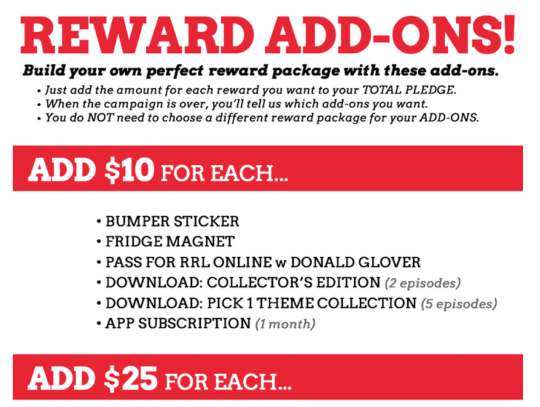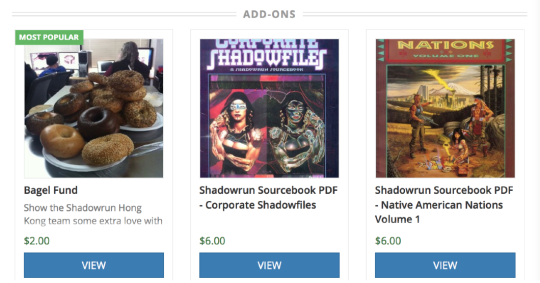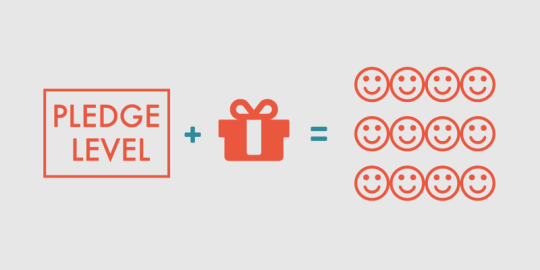What is an Add-On?
An add-on is an optional item that can be added to a Kickstarter pledge without changing pledge levels. Adding-on isn’t actually a Kickstarter function—it’s a feature that project creators like yourself have pioneered as a way for backers to customize their rewards. An add-on is a bit like a side-order from a restaurant menu: if you’ve ordered the pancakes, maybe you’d like to “add-on” a side of delicious sausage for an extra $2.
Add-ons were pioneered and introduced by tabletop gaming project creators, who have used them to allow backers to add expansion packs, extra cards and game pieces. Since then, add-ons have become popular for projects in every category. In the example below, Calaveras playing cards encourages their backers to add-on extra decks, T-shirts, and stickers by adding funds to their pledges.

Why Create Add-Ons?
Kickstarter and Indiegogo backers already expect to be able to pledge for the exact items they want. People support crowdfunding projects to express their individuality, so it’s great to give them the option to customize their rewards. Also, from the backer’s point of view, it always seems like purchasing another item should be a perfectly reasonable request.
In any case, it’s a great opportunity to keep your existing backers excited while raising money for your project. As the old sales adage goes, it’s much easier to offer something to an existing customer than to seek out a new customer. And even projects that explicitly state “No-Add Ons!” in their FAQ’s will see backers that increase their pledges, requesting to add items from other pledge levels to their orders.
How to Set up Add-Ons
Depending on how you price things, you could decide to offer the complete add-on menu to all, or to make certain add-on items available only to specific pledge levels. You’ll need to create an add-on menu that details each item and its price. You’ll also want to tell people how to add funds in Kickstarter, letting them know that they can click “manage your pledge” to increase the dollar amount. You should probably suggest that add-on backers send you a Kickstarter message, too.

Then, you’ll need to survey backers to find out which items they’ve elected to add on. This is by far the most challenging step in the process, as there are a few potential snags you could run into. Backers that haven’t already added funds will request to add-on after the fact, and it may be difficult to present the survey only to backers who have added funds above their pledge levels. If your add-on menu is simple, you may be able to figure out what you need to know with the Kickstarter survey, but it will still require some manual work on your part.
If you’re using a pledge management system like BackerKit, add-ons become a whole lot easier. You don’t need to offer any instructions prior to the end of the campaign, because backers will automatically be presented with an add-on “store” with the ability to add on items after the fact. Backers will have more time to customize their orders, too—and there’s no need to keep track of anything manually.

BackerKit Add-Ons Menu
Whether you decide to introduce add-ons or not, we’d like to congratulate you on beginning your crowdfunding journey.
